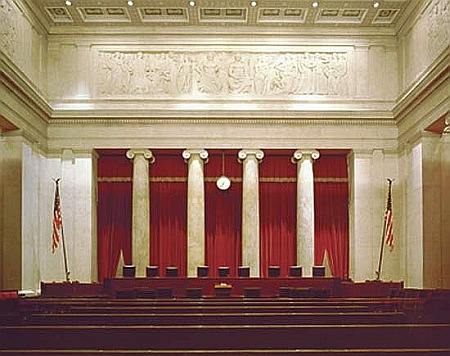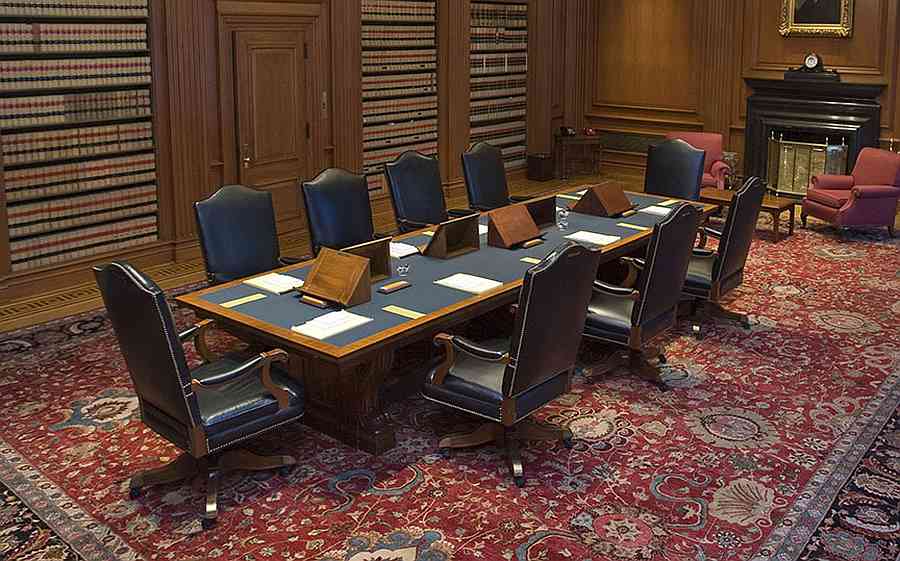|
| |
|
United States Supreme Court
|
|
| "The judicial Power of the United States, shall be vested in one Supreme Court, and in such inferior Courts as the Congress may from time to time ordain and establish." - Article III, Section 1, United States Constitution |
 |
| Established by the United States Constitution, the Supreme Court began to take shape with the passage of the Judiciary Act of 1789 and has enjoyed a rich history since its first assembly in 1790. The Supreme Court is deeply tied to its traditions: Of the federal government’s three branches, the Court bears the closest resemblance to its original form – a 225 year old legacy. The Supreme Court Building, majestic in size and rich in ornamentation, serves as both home to the nation’s highest Court and the manifest symbol of its importance as a coequal, independent branch of government.
The Supreme Court first met in the Merchants Exchange Building in New York City and then moved to Independence Hall in Philadelphia when the federal government moved there in 1790. In 1800, when the federal government moved for a final time to Washington, D.C., the court met in various rooms in the Capitol Building.
The Court convened for a short period in a private house after the British set fire to the Capitol during the War of 1812. Following this episode, the Court returned to the Capitol and met from 1819 to 1860 in a chamber now restored as the 'Old Supreme Court Chamber.' Then from 1860 until 1935, the Court sat in what is now known as the 'Old Senate Chamber,'" according to SupremCourt.gov. |
|
| In 1929, "architect Cass Gilbert was charged by Chief Justice Taft to design 'a building of dignity and importance suitable for its use as the permanent home of the Supreme Court of the United States.'" Construction was completed in 1935, and the court moved to its permanent residence at One First Street Northeast, Washington, D.C. |
|
 |
The Supreme Court Building, located at One First Street, NE, in Washington, DC - View Map |
 |
| The main entrance to the Supreme Court Building is on the west side, facing the United States Capitol. A few low steps lead up to the 252-foot-wide oval plaza in front of the building. Flanking these steps is a pair of marble candelabra with carved panels on their square bases depicting: Justice, holding sword and scales, and The Three Fates, weaving the thread of life. On either side of the plaza are fountains, flagpoles, and benches.
The bronze flagpole bases are crested with symbolic designs of the scales and sword, the book, the mask and torch, the pen and mace, and the four elements: air, earth, fire, and water.
On either side of the main steps are seated marble figures. These large statues are the work of sculptor James Earle Fraser. On the left is a female figure, the Contemplation of Justice. On the right is a male figure, the Guardian or Authority of Law.
Sixteen marble columns at the main west entrance support the pediment. On the architrave above is incised "Equal Justice Under Law." Capping the entrance is a sculptured group by Robert Aitken, representing Liberty Enthroned guarded by Order and Authority. On either side are groups of three figures depicting Council and Research which Aitken modeled after several prominent individuals concerned with the law or the creation of the Supreme Court Building. At the left are Chief Justice Taft as a youth, Secretary of State Elihu Root, and the architect Cass Gilbert. Seated on the right are Chief Justice Hughes, the sculptor Aitken, and Chief Justice Marshall as a young man. |
 |
The Supreme Court is the highest court in the Nation for all cases and controversies arising under the Constitution or laws of the United States and leads the judicial branch of the federal government. It is often referred to by the acronym SCOTUS.
The Supreme Court consists of nine justices: the Chief Justice of the United States and eight Associate Justices. The justices are nominated by the president and confirmed with the "advice and consent" of the United States Senate per Article II of the United States Constitution.
As federal judges, the justices serve during "good behavior," which means that justices have tenure for life unless they are removed by impeachment and subsequent conviction. |
Supreme Court Bench |
|
| The Supreme Court is the only court established by the United States Constitution (in Article III); all other federal courts are created by Congress. The Supreme Court meets in Washington, D.C., in the United States Supreme Court building. The Supreme Court's yearly term begins on the first Monday in October and lasts until the first Monday in October the following year. The court generally releases the majority of its decisions in mid-June. |
 |
Supreme Court Conference Room - This is where cases are dicussed and decide. |
|
 |
The Supreme Court of the United States is located at 1 First Street, NE between East Capitol Street and Maryland Avenue. You do not need a ticket to get in, it is free and available on a first-come, first-served basis.
The Supreme Court does not offer guided walking tours, visitors are encouraged to tour public portions of the building on a self-guided basis and take advantage of a variety of educational programs, including Courtroom Lectures, a Visitor Film, and court-related Exhibitions. In addition to the Courtroom, portions of the first and ground floors are open to the public.
The Supreme Court Building is open to the public Monday – Friday from 9:00 a.m. to 4:30 p.m. It is closed on weekends and all federal holidays. |
|
Visitors may enter the building from the Plaza doors located on each side of the main steps. A wheelchair accessible ramp is located along Maryland Avenue on the left side of the building.
All visitors must pass through security screening before entering the building. During the months of March – June, visitors should anticipate longer wait times to enter the building due to larger crowds visiting the Nation’s Capital. |
 |
Vintage Postcard of The United States Supreme Court Building, Completed in 1935 |
| |
|
|
|